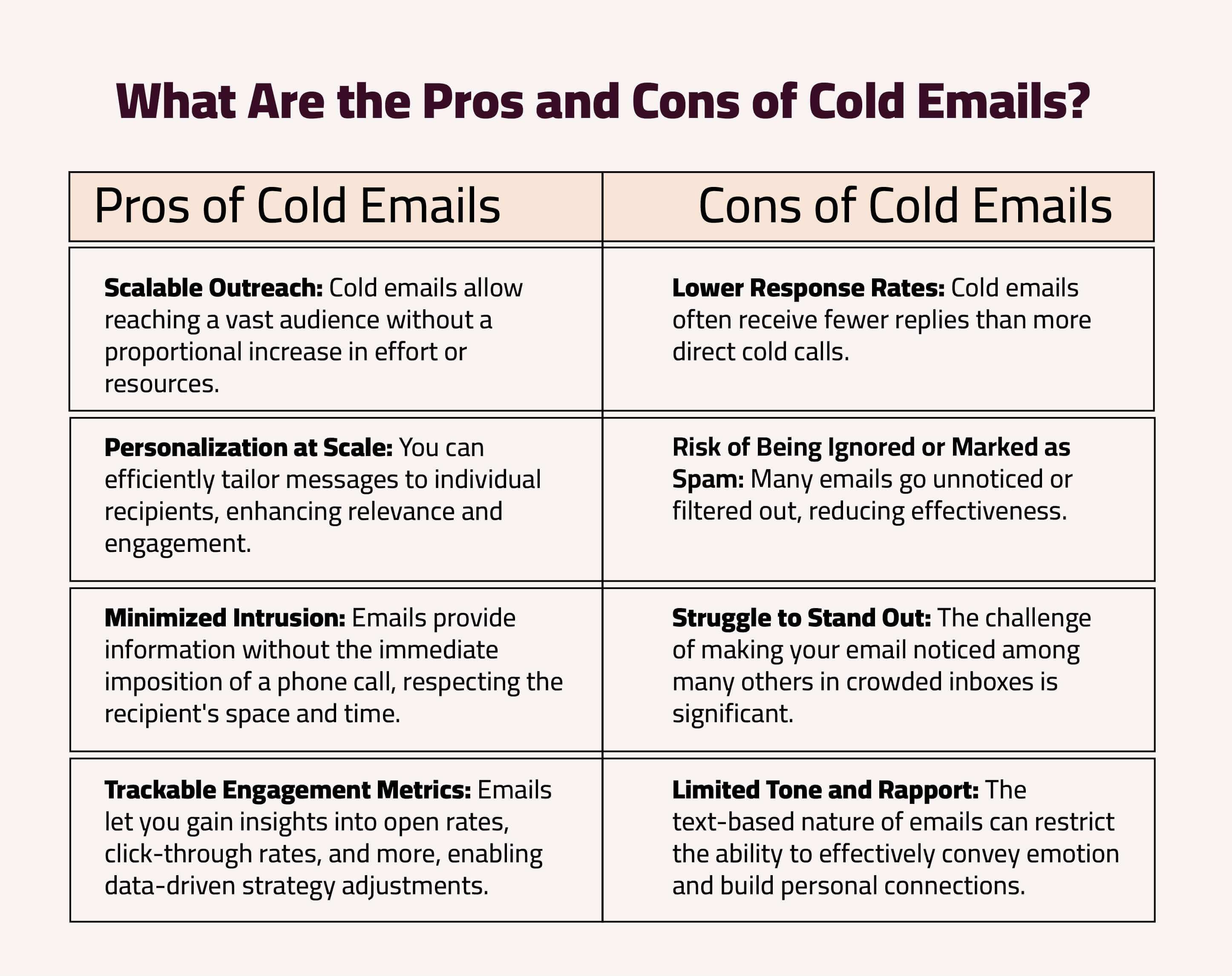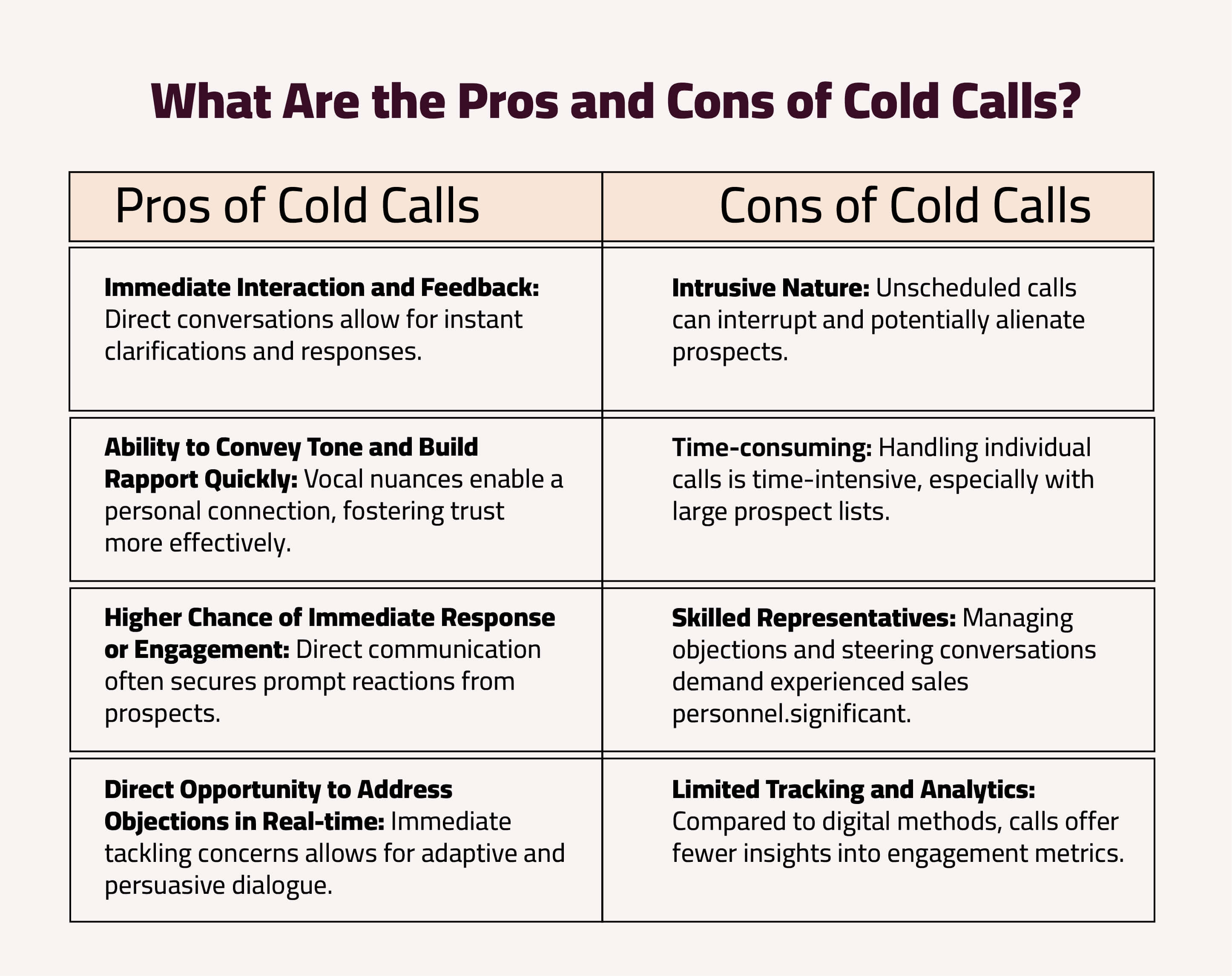
Cold Calling vs. Cold Emailing - Master Your Outreach Strategy
Have you ever considered the sheer impact of your opening line in a cold email? If not, check this out:
Emails with personalized subject lines can boost open rates by 50%. Cold emailing has an average conversion rate of 15.11%.
Next, let's shift gears to cold calling, where you cannot underestimate the power of your voice’s immediacy. Despite the digital age's allure, the human touch of a call can cut through the digital noise.
Hence, calls offer clarity and connection that emails might only sometimes convey. That’s the reason 92% of customer interactions happen over the phone.
The battle between cold calling and cold emailing is unending. But we will not pick sides as we dig deep. Instead, we will unpack the nuanced dynamics of each approach.
From the tailored precision of cold emailing to the personalized engagement of cold calling, we will equip you with the insights to make each interaction count. Are you ready to navigate the intricacies of these sales techniques? Let’s start.
Why Is Cold Emailing Important?
Cold emailing is a pivotal strategy in outbound sales for various compelling reasons:
1. Scalability
Cold emailing enables you to broaden your outreach effortlessly, reaching a vast array of potential clients with just a few clicks. This aspect is particularly beneficial for businesses aiming to expand their reach without proportionately increasing their outreach efforts or expenses.
2. Automation and Personalization
Modern cold emailing tools can automate the sending process while allowing personalization. You can send tailored messages to a large audience, making each recipient feel uniquely addressed. It can significantly enhance engagement rates.
3. Performance Monitoring
One of the standout features of cold emailing is the ability to track various metrics such as open rates, click-through rates, and conversion rates. This data is invaluable for:
- Assessing the effectiveness of your campaigns
- Making data-driven adjustments to improve future outcomes
4. Cost-Effectiveness
With minimal costs associated with sending emails, cold emailing provides a high ROI. Hence, it’s an attractive option for businesses of all sizes, from startups to established corporations. This efficiency is especially crucial for companies operating with limited marketing budgets.
5. Non-Intrusive Nature
Cold emails offer the recipient the convenience of engaging with the content at a time that suits them best. This method respects their schedule and preferences.
6. Reaching Prospects Where They Are
Given the widespread use of email in professional settings, cold emailing ensures your message lands where most professionals are already paying attention - their inbox. It increases the likelihood of your message being seen and acted upon.
Why Is Cold Calling Important?
Cold calling plays a pivotal role in the sales process for several key reasons:
1. Critical Sales Intel
Cold calling allows your sales professionals to engage directly with potential customers. It provides an immediate opportunity to gather valuable insights about:
- Customer needs
- Market trends
- Competitor information
This direct interaction facilitates a deeper understanding of the prospect's business challenges and how your product or service can offer solutions.
2. New Leads in the Funnel
It is an effective method of introducing your product or service to new prospects who may not be aware of your company. By proactively reaching out, you can expand your customer base and fill your sales funnel with fresh leads. This increases the potential for conversions and revenue growth.
3. Speedier Process
The immediacy of a phone call can significantly accelerate the sales cycle. A phone conversation demands instant engagement. It allows for quicker qualification of leads and more efficient movement of prospects through the sales funnel.
4. Warm Prospects Identification
Cold calling helps quickly identify prospects genuinely interested in your product or service. Real-time conversations allow sales representatives to assess the prospect's enthusiasm and readiness to buy, enabling them to focus their efforts on leads with the highest potential for conversion.
5. Improved Sales Pitches
Each cold call is an opportunity to refine and enhance your sales pitch. Real-time feedback from prospects allows sales professionals to adjust their approach, messaging, and techniques.
Hence, the communication resonates better with potential customers. It improves the effectiveness of your sales strategy.
6. Stronger Rapport from the Start
Cold calling facilitates the building of personal connections early in the customer journey. The human element of voice communication can foster trust and rapport more effectively than text-based communications. It lays a solid foundation for a strong customer relationship.
As you can see, these outbound approaches are critical for your sales outreach efforts. However, there are certain drawbacks and benefits you must be aware of – for each technique. Let’s check them out:
What Are the Pros and Cons of Cold Emails?
First up, let’s discuss the upsides and downsides of cold emails:

What Are the Pros and Cons of Cold Calls?
Next, let's weigh its advantages against the challenges of cold calling:

Now that you understand the advantages and disadvantages of each approach, here is the next inevitable question: Which technique should you choose? Well, your decision depends on several factors. Let’s check them out:
Factors Influencing the Choice between Cold Emails and Cold Calls
When deciding between cold emails and cold calls, multiple elements come into play, shaping the strategy best suited for your sales goals:
1. Nature of the Product/Service
Complex, high-value products might benefit from cold calls' direct, personal touch. It allows for detailed explanations and immediate answers to questions. On the other hand, simple offerings would suffice with a direct email.
2. Target Audience
Different demographics might have distinct communication preferences. For example, younger audiences may lean towards email, valuing its non-intrusive nature and convenience.
3. Industry and Market
Again, your choice will depend on the industry. For example, in the enterprise software industry, where complex solutions require buy-in from multiple stakeholders, cold calling is particularly effectual.
In contrast, cold emailing can be highly beneficial for marketing consulting services, where reaching out to potential clients in a nonintrusive manner is essential.
4. Sales Team Skills
The choice might also depend on your team's strengths:
- Cold emails could be your solution if your team excels at writing compelling emails and analyzing metrics.
- Conversely, cold calling might be more effective if they have strong verbal communication skills.
5. Stage of the Sales Funnel
Cold emails can be great for initial outreach, providing information without demanding immediate attention. Cold calls, however, might be more effective for later stages, where direct interaction can push a lead toward a decision.
6. Regulatory Considerations
Depending on your industry and location, specific regulations governing cold calling or emailing might impact your choice. We’ll explore this in more detail later.
That being said, let’s now explore some of the best practices to benefit from both these approaches.
Best Practices to Maximize the Impact of Cold Calls and Emails
To maximize the impact of your cold emails, consider these best practices:
- Mastering Subject Lines: Short, intriguing subject lines tend to perform better, capturing attention and sparking curiosity without revealing too much.
- Aim to create a hook or teaser that compels the recipient to learn more.
- Utilize questions, power words, or hints at content that solves a problem.
- Leveraging Personalization Techniques: Go beyond simply inserting the recipient's first name by incorporating details relevant to their industry, interests, or recent activities.
Demonstrate familiarity with their specific challenges or achievements to increase engagement. - Being Clear About Value Propositions: Your email should clearly articulate how your offering benefits recipients, addresses their needs or solves their problems.
Keep your message concise and focused on the value, avoiding overly technical jargon or complex explanations.
- Crafting CTAs with Precision: Be clear about what you want the recipient to do next, whether it's:
- Scheduling a call
- Downloading a resource
- Visiting a webpage
Create precise, actionable CTAs to guide the prospect toward the desired outcome. Also, A/B tests various versions to identify the most effective CTAs to motivate prospects to take the following action.
- Following Up with Finesse: Time your follow-ups – not too soon to be pushy, but not too late that the recipient forgets the initial contact.
Persistence, coupled with thoughtful timing, can significantly improve response rates. Consider leveraging insights from previous interactions to tailor your follow-up approach.
Now, to maximize the impact of your cold calls, consider these refined strategies:
- Researching Your Targets: Before making a call, gather detailed insights about your prospects, such as their:
-
- Business needs
- Challenges
- Interests
Use platforms like LinkedIn to understand their business context and tailor your pitch accordingly. This preparatory step makes your call relevant and engaging to the prospect.
- Scripting with Purpose: Develop a cold calling script that highlights the benefits of your offering while anticipating potential objections. However, your script should be a guideline rather than a rigid document to be recited verbatim.
Maintaining the flexibility to adapt the conversation based on the prospect's responsesis essential.
- Listening and Learning: Active listening is vital in cold calling. Pay close attention to the prospect's feedback and adapt your approach accordingly. It shows that you value their input and helps you to refine your pitch.
- Understanding Objection Handling Strategies: Anticipate common objections and prepare strategies to address them. Understanding prospects' typical concerns enables you to navigate the conversation more effectively. It will keep the dialogue moving toward a positive outcome.
- Following Post-Call Protocol: After each call, document the key points discussed, any feedback received, and the next steps agreed upon. It will help you to follow up more effectively and maintain a clear record of your interactions with each prospect.
Blend Cold Calling and Cold Emailing for an Optimized Sales Strategy
So, what should be the ideal approach? Merge cold calling and cold emailing to boost your sales strategy. Engage potential buyers at various points in their decision-making process.
After all, the modern customer journey is complex and often spans multiple platforms and channels. A combined approach allows for more nuanced and adaptable engagement with prospects.
Here's a more detailed breakdown of how you can further enhance this integration:
1. Integrating with CRM Systems
Customer Relationship Management (CRM) tools track all interactions with prospects, including:
- Emails sent
- Calls made
- Responses received
This data enables your sales teams to tailor their follow-ups more personally based on the prospect's behavior and preferences, leading to a deeper understanding of customer needs.
2. Embedding Technological Tools
Today's market offers many software designed to streamline cold calling and emailing processes:
- Email automation platforms allow for scheduled, personalized email campaigns.
- Call analytics software provides detailed feedback on call outcomes.
3. Following Compliance and Regulations
You should understand and comply with regulations surrounding cold outreach, such as:
- The General Data Protection Regulation (GDPR) in Europe
- The Controlling the Assault of Non-Solicited Pornography And Marketing (CAN-SPAM) Act in the U.S.
- The California Consumer Privacy Act (CCPA)
- The California Privacy Rights Act (CPRA)
Adherence to these laws ensures legal compliance and helps maintain your brand's integrity and trustworthiness.
4. Introducing Training and Development
Continuous learning is essential for sales teams to stay at the top of their game in cold calling and emailing. It might involve formal training programs, workshops, or self-guided learning – focusing on the latest sales technologies, methodologies, and best practices.
5. Incorporating Feedback Mechanisms
Implement mechanisms to collect and analyze feedback from cold calling and cold emailing campaigns for ongoing improvement. This can include customer feedback, A/B testing of different approaches, and analysis of sales call data to refine and enhance future sales pitches.
The Bottom Line
Nurture genuine connections through cold emails and calls to maximize conversions and foster lasting business relationships. Combine the personal touch of a phone conversation with the convenience and thoughtfulness of an email to create a well-rounded outreach. This approach caters to different preferences and maximizes the chances of making a meaningful connection.
For more detailed guidance and tips on effectively combining cold emails and cold calls, consider partnering with an outbound agency like Revnew. Our team is continuously updated with the latest trends in B2B marketing. Contact us now.




